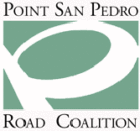[NOTE: The first post on this subject can be see at “Posted 12/22/17: North San Pedro Road Issues“]
Supervisor Damon Connolly convened a follow-up meeting February 23, 2018 to begin to identify goals and objectives for short-term fixes to the China Camp road safety, flooding and environmental issues identified in December. Again the meeting was extremely well-attended with broad representation from the county, city, state parks, Friends of China Camp, National Estuarine Research System (NERRS), MMWD, state and federal permitting agencies, SPRC and Santa Venetia Neighborhood Association (SVNA), and very productive.
Stuart Seigal, Ph.D., NERRS Coastal Resilience Specialist stated that the grant proposal for the NERRS Catalyst Grant (Bringing Together End Users and Stakeholders to Identify and Evaluate Sea Level Rise Adaptation Options to Solve Road Flooding in China Camp State Park) had been submitted. The grant outlines two critical outputs:
- China Camp shoreline road reconfiguration options with qualitative evaluation.
- Strategy for moving forward to develop and implement China Camp shoreline road reconfiguration.
Many organizations represented at the meeting, including the SPRC submitted letters of support for this highly competitive grant. NEERS requested $157,000 for a one-year period which will fund in September if awarded.
The remaining portion of the meeting was a highly collaborative brainstorming session to generate and gain agreement on short term goals and measurable objectives for the North San Pedro Road issues. Short term was defined as 2018 prior to the next flood tides to 2020/2021(?). The goals/outcomes identified were:
- Reduce public safety hazards
- Maintain road access except during event flooding
- Reduce impacts from parking on road shoulder to marsh and recreation
- Maintain future road reconfiguration options
- Maintain near-term ecological connectivity of inland marshes
The next meeting to be held June 4 will be used to evaluate, prioritize and determine the implementation feasibility of short-term actions. Actions will be measured in terms of how well they support a particular goal and/or objective, and their degree of implementation feasibility as measured by their installation and O&M costs, stakeholder support, consistency with CDPR requirements, ecological impacts and regulatory burden.
